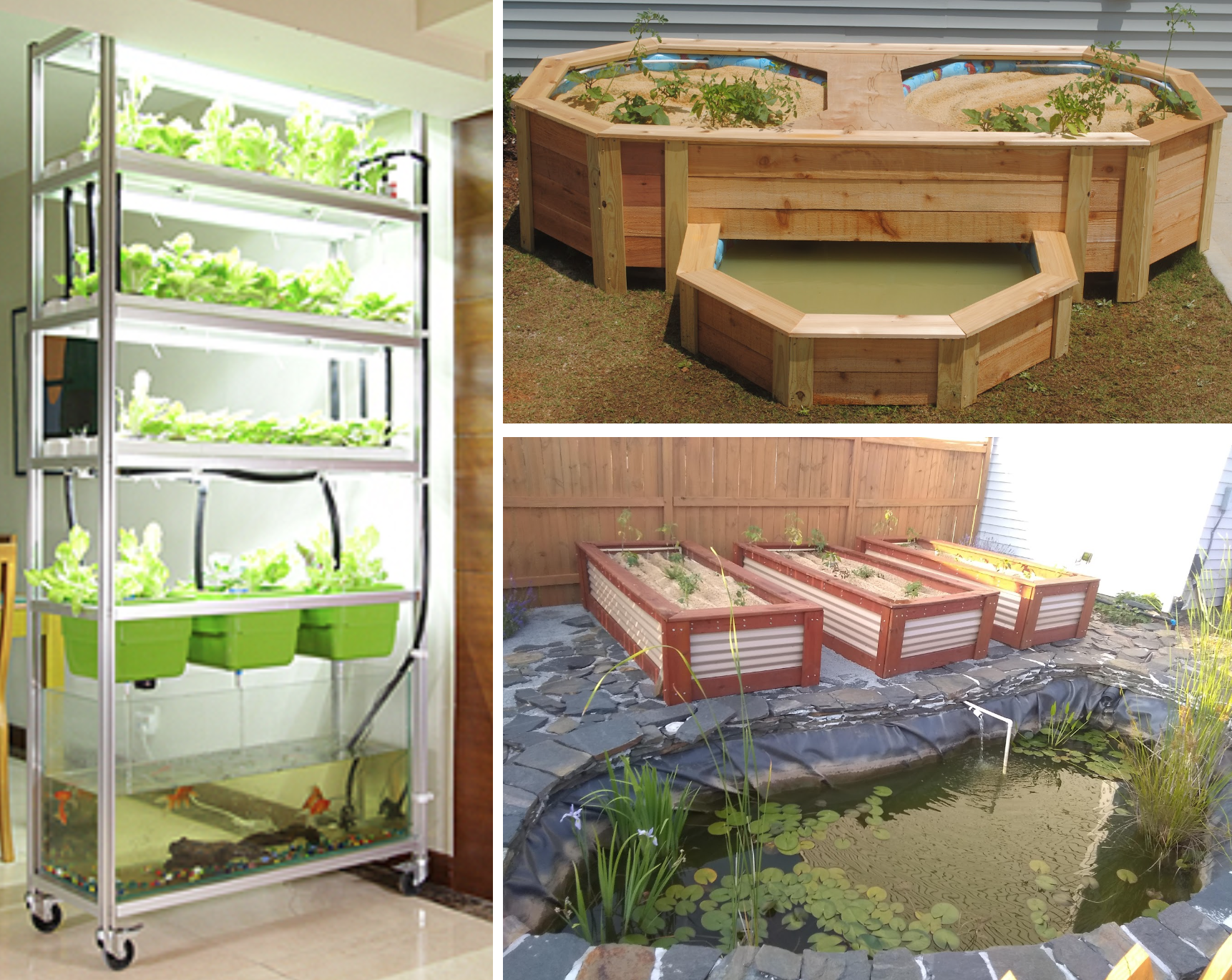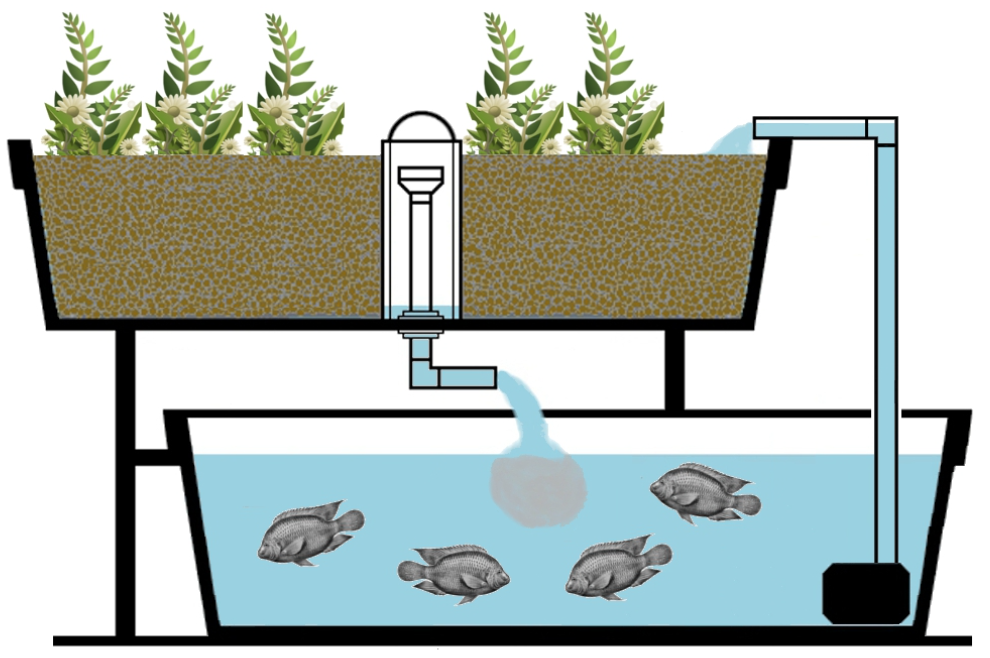Aquaponics, simply defined, is using the water from a fish tank (or a pond, or an aquarium) to provide nutrients for plants so that they can grow without soil: quite an interesting ecological food system! This article is an introduction to aquaponics.
To start, here is a simple and quick explanation of aquaponics. Essentially, fish are grown in a fish tank, and the water in the aquarium that has become filled with fish waste is reused to saturate a plant bed that is hydroponically grown (meaning the plants get their nutrients from water-based solvents instead of soil). If the concept of aquaponics is still a bit confusing, here is a cool video that shows aquaponics in action. Now, it is possible to simplify aquaponics down to four words: fish, water, plants, and bacteria. There are obviously many other factors to consider with these systems, but since this is an introduction, only the four listed will be discussed.
The fish that are chosen for this efficient farm system are quite important. Some of the most popular fish to use for aquaponics are tilapia, catfish, and goldfish because of how readily available they are. Koi is also a great choice for beginners in aquaponics alongside these two fish species. If you would like to read more about what kind of fish would be preferable for aquaponics, see this article.
Before moving on to the type of water to use in an aquaponics system it would be good to explain how fish waste is integrated into nutrients that the plants can absorb. This article helps describe this whole process. To start, it explains that while fish waste is high in ammonia, which can be toxic to smaller fish, the waste water is pumped into the fish tank through a filter and then into the plant bed. In the plant bed, bacteria will break down the ammonia into nitrite, which other bacteria will then convert into nitrates. Nitrates are taken up by the plants into fertilizer, so this whole process cleans the water of harmful ammonia, allowing clean water to come into the fish tanks. This is why a high-surface-area growing medium is preferred since there will be more surface for the bacteria to grow on, and the ammonia → nitrites → nitrates conversion process will happen all that much faster and better.
Now a question you might have is “what kind of water should I use in an aquaponics system?”. The ideal source of water would be rainwater, which is fresh and pure. To get into more of the nitty-gritty details of the maintenance and monitoring of the water in an aquaponics system, see this article. If rainwater would take too long to collect, you can use well water or chlorinated water, but if you use the latter option, make sure to wait a few days before introducing fish to the system. This allows the chlorine to off-gas.
Lastly, here is a description of the plants you can grow in aquaponics. This article elaborates on which types of fruits and vegetables can be grown with an aquaponics system, and you might notice that many of the standard plants found in a regular garden are listed. Also, since an aquaponics system does not require a need for soil to provide nutrients for the plants, things like coarse sand, gravel, and expanded clay pellets can be used to hold the plants in place while allowing water to easily flow through the system. (Just remember the earlier mention of using a medium with a high surface area for the beneficial bacteria.)

All of this info might bring up the question why you would want an aquaponics system in the first place, and the primary reasons people use such systems is for the efficiency and how water is reused in order to have a sustainable and environmentally-friendly system. It is also notable to point out that you can have a multitude of sizes and layouts for these aquaponics systems. For example, one could have an indoor system that consists of an aquarium and shelves with containers for the plants, an outdoor patio system built with wading pools, or a backyard-sized system containing a fish pond and several raised beds. Andrew has built and run these systems in the past. This allows for variety and adaptability regardless of where people live!
Here is some of the latest research and developments in aquaponics systems. First off, in mid-February of 2023, Purdue University received a $10 million dollar grant from the USDA which would be used to create an aquaponics facility to create a sustainable source of tilapia and lettuce (read more about it in the first and second articles). This is great news because as more money is invested there is more opportunities for development and growth so that even the “20% wastewater” mentioned in the first linked article can potentially be reduced and even reused.
Secondly, a Northeast-based greenhouse named Springworks is announcing an expansion of their facilities by 120,000 square feet thanks to $22 million of new funding. This will allow the greenhouse to grow more food for their local population in a more resilient and sustainable manner.
Thirdly, In terms of technological advances for aquaponics, there have been recent developments that further improve the aquaponics system as a whole and further develop it to become more efficient and economical. These developments include things such as bell siphons, decoupling systems, and LECs, which can all be read about in this article. Also, there is further research being done by Auburn university about algal biofloc (a mixture of algae and bacteria that transforms nutrients into less toxic forms for fish and plants) within aquaponics systems.
You can see how aquaponics has a bright future and is worth exploring. Even if it may seem daunting, there is already a well-established network of resources at your disposal, so do not hesitate to do further research, learn about these cool systems, and contact us with any questions you may have!

